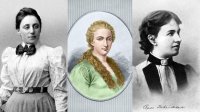How to Support Girls in Forming a Positive Math Identity
A look at one way high school math teachers can guide female students to overcome stereotypes and develop a positive sense of their math abilities.
Your content has been saved!
Go to My Saved Content.Identity formation, including mathematical identity, is a lifelong process. Supporting high school students as they continue to develop a positive mathematical identity is essential for their-long term enjoyment of, and success in, mathematics. This entails—among other things—fighting some strong cultural associations we have with the nature of math abilities, such as the stereotype that certain people are more likely to possess innate math skills.
As a math teacher, I’ve always felt an obligation to build welcoming and inclusive math communities. Teaching in an all-girls’ school requires me to be particularly thoughtful and intentional about instilling and building a sense of belonging to the math community with this particular group of young mathematicians—women—that has been disadvantaged in the learning of and access to high-level mathematics.
All students need to feel part of the math community, because their identity as mathematics learners shapes their willingness and ability to engage in mathematics work. Without a strong positive math identity, they have little motivation to engage with math that’s challenging and to persevere when they face challenges. This is never more true than in calculus classes, when the challenges become real even for the most dedicated learner.
One of the classroom practices and strategies that support students’ development and strengthen their positive identity as learners and doers of mathematics is confronting the stereotypes of who can be a mathematician. To this end, a project that centers on the lives and achievements of three historical women mathematicians helped my calculus class discover and reflect not only on these mathematicians’ multifaceted talent but also on the many biases and societal expectations that hampered these women’s careers.
Spotlight on Women Mathematicians
The National Math Festival is a source of endless inspiration and resources, and when they sent me some information about the play The Witches of Agnesi, I knew I had found a jewel: This is a play, as the site explains, “that brings together three women mathematicians—Maria Agnesi, Sofya Kovalevskaya, and Emmy Noether—from three different centuries in a mysterious meeting place outside of ordinary time and space, where they share a pot of tea and tell the stories of their lives and careers.”
The play, which viewers can watch as a stand-alone video or with a panel conversation that follows the play, is sparingly staged and performed—which for me movingly adds to the representation of the important work that women mathematicians do and questions why women have faced so many barriers. The title of the play comes from the name of the most important curve that Agnesi studied, and which she named “versiera,” later somewhat playfully mistranslated as “witch.”
Reflection and Response
After asking the students to watch the play, I provided them with a few reflection questions, such as these:
- What have you learned from this play? Did you know of any of these mathematicians?
- Do you see common threads among the lives and works of these three women?
- What was your reaction to this play? Did you like it? Why or why not?
- Please share your thoughts about these women mathematicians and their stories. What do you think of each of these three people?
- If you could meet one of these mathematicians for dinner, who would you like to meet and why? What questions would you have for her, and what would you two talk about?
After watching the play, the students responded to some prompts and to each other’s entries in the Women in Math blog that I created for this specific project. Their interesting, heartfelt, and uplifting blog posts were inspiring and continue to motivate me to develop similar tasks that encourage the students’ sense of belonging to the larger mathematics community and strengthen their identity as members of that community.
For evaluating this project, I created a rubric—there are many ready-made rubrics on the internet, including these from Intel Teach Elements and the University of Wisconsin. There are also tools that allow educators to create and shape their own rubrics around the competencies they want to foster and assess.
As a class, we also had a final conversation that helped evaluate what the students got out of this project. Teachers can develop and deepen this type of conversation into an interdisciplinary exercise with educators of other subjects (such as history) or topics (some particular aspect of the mathematics that the three mathematicians in question studied).
Finally, we initiated peer reviews, in the form of a short guided or structured paragraph on a limited number of peer entries and a rubric on a larger number of peer posts. Besides being helpful to the teacher, these are a very effective tool for student engagement and further reflection.
In closing, math teachers can support their students’ identity simply by pondering the question posed by the NCTM president in a December 2021 communication: “When you consider your mathematics community, whom does it include?”
